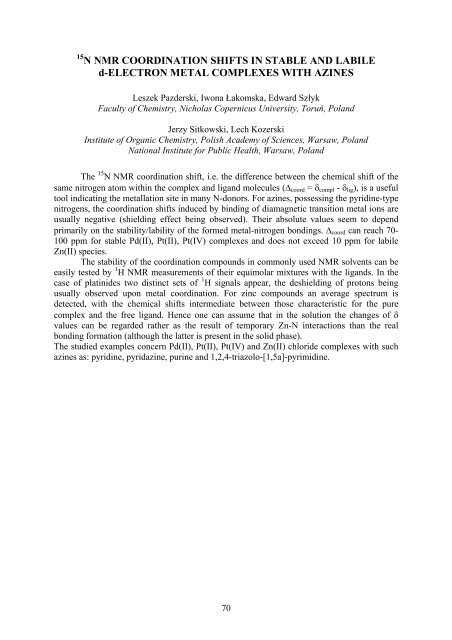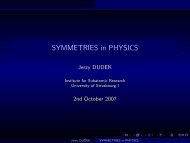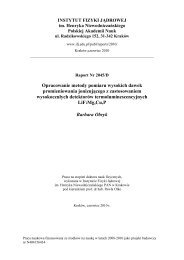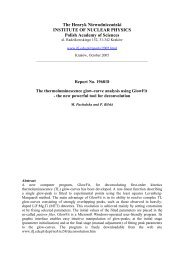Report No xxxx - Instytut Fizyki JÄ drowej PAN
Report No xxxx - Instytut Fizyki JÄ drowej PAN
Report No xxxx - Instytut Fizyki JÄ drowej PAN
You also want an ePaper? Increase the reach of your titles
YUMPU automatically turns print PDFs into web optimized ePapers that Google loves.
15 N NMR COORDINATION SHIFTS IN STABLE AND LABILE<br />
d-ELECTRON METAL COMPLEXES WITH AZINES<br />
Leszek Pazderski, Iwona Łakomska, Edward Szłyk<br />
Faculty of Chemistry, Nicholas Copernicus University, Toruń, Poland<br />
Jerzy Sitkowski, Lech Kozerski<br />
Institute of Organic Chemistry, Polish Academy of Sciences, Warsaw, Poland<br />
National Institute for Public Health, Warsaw, Poland<br />
The 15 N NMR coordination shift, i.e. the difference between the chemical shift of the<br />
same nitrogen atom within the complex and ligand molecules (∆ coord = δ compl - δ lig ), is a useful<br />
tool indicating the metallation site in many N-donors. For azines, possessing the pyridine-type<br />
nitrogens, the coordination shifts induced by binding of diamagnetic transition metal ions are<br />
usually negative (shielding effect being observed). Their absolute values seem to depend<br />
primarily on the stability/lability of the formed metal-nitrogen bondings. ∆ coord can reach 70-<br />
100 ppm for stable Pd(II), Pt(II), Pt(IV) complexes and does not exceed 10 ppm for labile<br />
Zn(II) species.<br />
The stability of the coordination compounds in commonly used NMR solvents can be<br />
easily tested by 1 H NMR measurements of their equimolar mixtures with the ligands. In the<br />
case of platinides two distinct sets of 1 H signals appear, the deshielding of protons being<br />
usually observed upon metal coordination. For zinc compounds an average spectrum is<br />
detected, with the chemical shifts intermediate between those characteristic for the pure<br />
complex and the free ligand. Hence one can assume that in the solution the changes of δ<br />
values can be regarded rather as the result of temporary Zn-N interactions than the real<br />
bonding formation (although the latter is present in the solid phase).<br />
The studied examples concern Pd(II), Pt(II), Pt(IV) and Zn(II) chloride complexes with such<br />
azines as: pyridine, pyridazine, purine and 1,2,4-triazolo-[1,5a]-pyrimidine.<br />
70

















